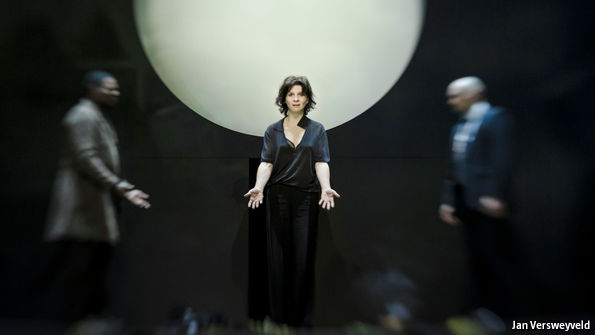via Prospero by E.W.

Those ancient Greeks could teach Hollywood a thing or two
On the bloodied Boeotian plains outside the seven gates of Thebes, Ismene struggles to persuade her sister Antigone to obey the edict of their uncle Kreon, the new head of state: “We’re girls,” she cries. “Girls cannot force their way against men.” Antigone will have none of it. She is determined to perform the sacred burial rites for her brother, Polyneikes, who was slain in a brutal civil war when he refused to relinquish the throne. Having deemed Polyneikes an enemy of the state, Kreon forbids any citizen from mourning his corpse. But Antigone is not easily cowed by the seemingly arbitrary decrees of men.
Continue reading
===================================
From Punch Cards to Holograms – A Short History of Data Storage
via MUO by Bryan Clark
In the world of data storage, there have been numerous breakthroughs, and even more flops that went absolutely nowhere. For every successful piece of data storage technology, there have been dozens more that were laughably bad.
Let’s take a look at some of the technologies that shaped modern data storage, as well as where we go from here.
Continue reading
===================================
Gershwin and color: how blue is the Rhapsody?
via OUP Blog by Olivia Mattis
Everyone knows George Gershwin as a composer, songwriter, pianist and icon of American music. But few know of his connections to the world of paintings and fine art. As a practising artist himself, Gershwin produced over 100 paintings, drawings, and photographs, most famously including his portrait of Arnold Schoenberg. “He was in love with colour and his palette in paint closely resembled the color of his music. Juxtaposition of greens, blues, sanguines, chromes, and greys, fascinated him,” recalled Merle Armitage. “Of course I can paint!” Gershwin was said to have told his girlfriend Rosamond Walling, an aspiring landscape painter. “If you have talent you can do anything. I have a lot of talent,” he added.
Continue reading
===================================
Charlie Chaplin’s scandalous life and boundless artistry
via Arts & Letters Daily: Richard Brody in The New Yorker

The most un-put-downable movie book of the season is also the most un-pick-uppable one: The Charlie Chaplin Archives (Taschen), which is the size of a small suitcase and weighs in at fourteen pounds, packed tightly with five hundred and sixty pages’ worth of thick and glossy paper bearing a treasure trove of superbly printed images alongside a relentlessly fascinating collage-like textual biography of Chaplin. It’s an apt tribute to the filmmaker, whose artistry transcends the cinema and spans world-historical dimensions.
Continue reading
===================================
Why can't we stop for death?
via 3 Quarks Daily: John Grey in New Statesman
When he was entering what he knew would be the final stage of his terminal illness, Bob Monkhouse used to joke that the terrible thing about dying was how stiff it left you feeling the next day. There is something pleasantly cavalier in the comedian’s quip. Why make a tragedy of something that will happen to us all? Perhaps we’d be wiser if we didn’t think of death at all, but instead – as the philosopher Spinoza recommended – only of life.
But that kind of wisdom seems to be beyond our capacity.
The human preoccupation with death is pervasive and universal, and every society offers remedies for the anxiety that the fact of mortality evokes. Religions have their afterlives, while secular faiths offer continuity with some larger entity – nations, political projects, the human species, a process of cosmic evolution – to stave off the painful certainty of oblivion. In their own lives, human beings struggle to create an image of themselves that they can project into the world. Careers and families prolong the sense of self beyond the grave. Acts of exceptional heroism and death-defying extreme sports serve a similar impulse. By leaving a mark, we can feel we are not just fleeting individuals who will soon be dead and then forgotten.
Continue reading
===================================
The Trouble with Theories of Everything: There is no known physics theory that is true at every scale – there may never be
via Arts & Letters Daily: Lawrence M. Krauss in Nautilus
Whenever you say anything about your daily life, a scale is implied. Try it out. “I’m too busy” only works for an assumed time scale: today, for example, or this week. Not this century or this nanosecond. “Taxes are onerous” only makes sense for a certain income range. And so on.
Surely the same restriction doesn’t hold true in science, you might say. After all, for centuries after the introduction of the scientific method, conventional wisdom held that there were theories that were absolutely true for all scales, even if we could never be empirically certain of this in advance. Newton’s universal law of gravity, for example, was, after all, universal! It applied to falling apples and falling planets alike, and accounted for every significant observation made under the sun, and over it as well.
Continue reading
===================================
New Database of Fictional Characters
via RB Firehose
“If you never see me again, it’s BoingBoing’s fault. It hipped me to a new database of fictional characters. ‘Basically CharacTour is an expansive online database for fictional characters. Like Facebook or a dating website, each character gets their own profile page. So far the site has over 4,500 spoiler-free profiles about characters’ origins, interests, skills, and journeys. Not only can you search for your favorites, you can find new characters to love as well.’
Jo March and Tony Stark were in the database, while Eve Dallas and Dirk Struan weren’t.“
Nor was Anne Shirley included
===================================
Scientific Revolutions in Optics Made Vermeer a Revolutionary Painter
via Big Think by Bob Duggan

Why do Vermeer’s paintings fascinate us so? Perhaps the reason lies behind a revolution in seeing in both art and science rooted in Vermeer’s 17th century Holland. During the heyday of tiny Holland’s position as a world power, in the city of Delft resided two remarkable men – the painter Johannes Vermeer and the scientist Antoni van Leeuwenhoek. While Vermeer painted images that changed forever how people see the world with their own eyes, Leeuwenhoek peered through microscopes to discover worlds only visible through technology. In Eye of the Beholder: Johannes Vermeer, Antoni van Leeuwenhoek, and the Revolution in Seeing, historian-philosopher Laura J. Snyder connects these two pioneers – born days apart, living close by all their lives, reunited in Vermeer’s death – to demonstrate how both modern art and modern science were born in that tiny city of Delft.
Continue reading
===================================
Yuval Noah Harari: the theatre of terror
via Arts & Letters Daily: Yuval Noah Harari in The Guardian

A fragment of the cockpit of the Pan Am Boeing 747 that exploded over the village of Lockerbie on 21 December 1988. Photograph: Letkey/AFP
Terrorists have almost no military strength so they create a spectacle. How should states respond? The author of Sapiens, a history of humanity, reflects on the past, and alarming future, of the fear factor.
Continue reading
===================================
Strangers Know What You Look Like Better Than You Do
via Big Think by Natalie Shoemaker

We’re bad at picking out pictures of ourselves that represent our true likeness, according to a new study. So, next time you’re picking out a picture for your dating profile, it may be better to get someone else to do it for you.
Continue reading
No comments:
Post a Comment